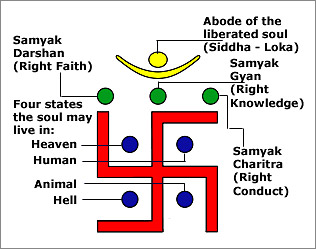 A soul is bound by the karmas since time immemorial. The first step to achieve moksha is to instill Samyaktva or rational faith or perception.
A soul is bound by the karmas since time immemorial. The first step to achieve moksha is to instill Samyaktva or rational faith or perception.
Samyaktva
According to Jainism, Samyak Darsana (Rational Perception), Samyak Jnana (Rational Knowledge) and Samyak Caritra (Rational Conduct), together also known as Ratnatraya or the three Jewels of Jainism, compose true Dharma. According to Umasvati, Samyak Darsana and Jnana Caritra together constitutes mokshamarga, or the path to liberation.
Samyak Darsana or rational perception is the logical faith in the true nature of every substance of the universe.
Samyak Jnana or rational knowledge is the right knowledge of true and appropriate knowledge of the reality, the tattvas. It comprises the two principles of Anekantvada or non-absolutism and Syadvada or relativity of truth. Right knowledge must be free from three main faults: doubt, delusion, and indefiniteness.
Samyak Caritra or rational conduct is the natural conduct of a (soul) living being. It consists in following asceticisms, pursuing right activities and observance of vows, carefulness and controls. Once a soul secures samyaktva, moksha is guaranteed within a few lifetimes.
Kevala Jnana
Kevala Jñana, the highest form of transcendental knowledge that a samyakdristi soul can achieve, also means "absolute knowledge", "Enlightenment" and "Omniscience". Kevala is the state of isolation of the java from the ajava attained through austere practices which burn off one`s karmic residues, releasing one from bondage to the cycle of death and rebirth. Kevala Jñana, thus signifies infinite knowledge of self and non-self, accomplished by a soul after eradication of the all ghatiya karmas. A person who has attained Kevala Jñana is called a Kevali. He is also known as Jina (the victor) or Arhat (the worthy one) and worshipped as the Almighty by the Jains. The soul who has reached this stage attains moksha at the end of his life span, after eradication of the aghatiya karmas.
Nirvana
Nirvana means final release from the karmic bondage. When an enlightened human, such as an Arhat or a Tirthankara crushes his remaining aghatiya karmas and ends his worldly existence, is termed nirvana. Theoretically, the death of an Arhat is called nirvana of Arhat, as he has ended his worldly existence and attained liberation. Moksha, to be precise, liberation follows nirvana. An Arhat becomes a siddha - the liberated one, after attaining nirvana.



















